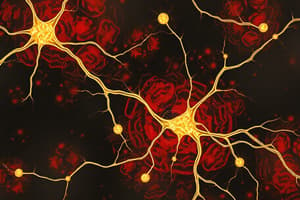Podcast
Questions and Answers
What is the compensatory-response model?
What is the compensatory-response model?
A version of preparatory-response theory in classical conditioning where the compensatory after-effects to a US are elicited by the CS.
What is stimulus generalization?
What is stimulus generalization?
- The tendency to respond only to the conditioned stimulus
- The tendency to respond to stimuli that are similar but not identical to a conditioned stimulus (correct)
- The learned ability to respond differently to similar stimuli
- None of the above
What occurs during stimulus discrimination?
What occurs during stimulus discrimination?
- Ignoring all stimuli
- Conditioning to a single stimulus only
- Responding similarly to all stimuli
- Responding differently to similar stimuli (correct)
What is classical conditioning?
What is classical conditioning?
What can unconditioned stimuli be classified as?
What can unconditioned stimuli be classified as?
What is the central goal of the compensatory-response model?
What is the central goal of the compensatory-response model?
What typically results from a low-intensity stimulus?
What typically results from a low-intensity stimulus?
What typically results from a high-intensity stimulus?
What typically results from a high-intensity stimulus?
What does the Dual-Process Theory of Habituation and Sensitisation propose?
What does the Dual-Process Theory of Habituation and Sensitisation propose?
Sensitisation defines an increase in responsiveness to a stimulus.
Sensitisation defines an increase in responsiveness to a stimulus.
What is the effect of repeated exposure to a stimulus in terms of habituation?
What is the effect of repeated exposure to a stimulus in terms of habituation?
The procedure of repeatedly pairing a neutral stimulus (NS) and an _____ is called classical conditioning.
The procedure of repeatedly pairing a neutral stimulus (NS) and an _____ is called classical conditioning.
What term describes the response that occurs after classical conditioning?
What term describes the response that occurs after classical conditioning?
Aversive unconditioned stimuli are typically used to establish classical conditioning in only one trial.
Aversive unconditioned stimuli are typically used to establish classical conditioning in only one trial.
Which of the following is NOT a key element of classical conditioning?
Which of the following is NOT a key element of classical conditioning?
What is the main outcome of sign tracking in animals?
What is the main outcome of sign tracking in animals?
What does the Preparatory Response Theory propose regarding the conditioned response?
What does the Preparatory Response Theory propose regarding the conditioned response?
What do we mean by learning?
What do we mean by learning?
Which processes are involved in learning according to the three levels?
Which processes are involved in learning according to the three levels?
All changes in behavior are a result of learning.
All changes in behavior are a result of learning.
What is non-associative learning?
What is non-associative learning?
What is habituation?
What is habituation?
Habituation typically makes a stimulus seem __________.
Habituation typically makes a stimulus seem __________.
Give an example of habituation.
Give an example of habituation.
What is sensitisation?
What is sensitisation?
Sensitisation is typically stimulus-specific.
Sensitisation is typically stimulus-specific.
Match the type of non-associative learning with its definition:
Match the type of non-associative learning with its definition:
What happens during dishabituation?
What happens during dishabituation?
Why does the first bite of food often taste the best?
Why does the first bite of food often taste the best?
Flashcards are hidden until you start studying
Study Notes
Learning Overview
- Learning is defined as the acquisition of knowledge or skills through experience, leading to changes in behavioral, physiological, and neural responses.
- Important types of learning include non-associative (habituation, sensitisation) and associative learning (classical and operant conditioning).
Non-Associative Learning
- Non-associative learning involves changes in response to a single stimulus based on repeated exposure.
- Two main types:
- Habituation: Decrease in response amplitude or frequency with repeated exposure to a stimulus. Typically stimulus-specific and can be short or long-term.
- Sensitisation: Increase in response amplitude or frequency from repeated exposure, usually not stimulus-specific. Often occurs in anticipation of an important stimulus.
Habituation
- Noticing novel stimuli leads to an orienting response, allowing focus on relevant information.
- Example: A cat initially panics at a new sound but habituates after daily repetition, continuing to eat without reaction.
- Involves tuning out unimportant stimuli to concentrate on more important cues.
- Dishabituation: Recovery of response to a previously habituated stimulus due to the introduction of a novel stimulus.
Sensitisation
- In contrast to habituation, sensitisation is marked by increased responsiveness.
- Example: Provoked by an annoying sound or unexpected event, leading to heightened alertness.
- Common in situations where significant events may occur (e.g., anticipation of an exam).
Distinction Between Habituation and Sensory Adaptation
- Habituation: A learned response where the organism can still perceive the stimulus if attention is directed toward it.
- Sensory Adaptation: A physiological process where sensory receptors fatigue, and the organism can no longer perceive the stimulus after some time (e.g., adjusting to darkness in a cinema).
Factors Influencing Habituation and Sensitisation
- Intensity of the stimulus matters: Low intensity usually leads to habituation; high intensity often causes sensitisation.
- Evolutionary significance can impact responses. For example, humans are unlikely to habituate to a baby's cry, emphasizing the need for an adaptive response.
Dual-Process Theory
- The initial increase in responsiveness (sensitisation) and the subsequent decrease (habituation) are thought to be linked processes; sensitisation counteracts habituation in many scenarios.
Real-World Examples
- People may habituate to familiar scents (like their pet), but notice those scents more strongly in other environments.
- Sensitisation is observed when minor repetitive distractions (like pen clicking during an exam) lead to increased irritation and loss of focus.
Research Implications
- Studies on infants show changes in attention based on the complexity of visual stimuli, demonstrating both habituation to simpler shapes and sensitisation to more complex patterns.
Practical Applications
- Understanding habituation can explain behaviors like preference for novel foods and why the first bite is often perceived as the tastiest.
- Both habituation and sensitisation play roles in everyday life, influencing attention, memory, and interactions with the environment.### Dual-Process Theory of Habituation & Sensitisation
- Sensitisation can occur during early stimulus presentations and introduction of unexpected stimuli from different modalities.
- Habituation and sensitisation are two co-occurring processes that affect observable behavior.
- Habituation leads to a decline in response specific to a stimulus with repeated exposure, strengthening over time.
- Sensitisation results in increased responsiveness during early trials that diminishes over time.
- The overall response is determined by the interplay of habituation and sensitisation.
Habituation and Sensitisation Overview
- Habituation:
- Repeated exposure to stimuli decreases the elicited response.
- Weaker stimuli lead to quicker habituation.
- Habituation effects show specificity to the original stimulus.
- Sensitisation:
- Repeated exposure increases the elicited response.
- Stronger stimuli lead to faster sensitisation.
- The increase in response generalizes to other stimuli within similar contexts.
Classical Conditioning Basics
- Classical conditioning involves pairing a neutral stimulus (NS) with an unconditioned stimulus (US) that elicits an unconditioned response (UR).
- Following conditioning, the NS transforms into a conditioned stimulus (CS), capable of eliciting a conditioned response (CR) similar to the UR.
Key Elements of Classical Conditioning
- Neutral Stimulus (NS): Initially does not elicit a response.
- Unconditioned Stimulus (US): Naturally elicits a response without conditioning.
- Unconditioned Response (UR): The natural response to a US.
- Conditioned Stimulus (CS): Formerly NS that now elicits a response due to conditioning.
- Conditioned Response (CR): Response to the CS after conditioning.
Examples and Mechanisms
- Classical conditioning exemplified by dogs associating jingling keys (NS) with separation anxiety (CR) when the owner leaves (US).
- Acquisition of learning follows a negatively accelerating curve, indicating a limit to the response training.
Types of Unconditioned Stimuli
- Appetitive US: Elicits approach behavior (e.g., food).
- Aversive US: Elicits avoidance (e.g., shock).
- Aversive classical conditioning can establish quickly due to the intensity of the US.
Response Theories
- Stimulus Substitution Theory: Proposes that the CS substitutes for the US, triggering the same neural responses.
- Preparatory Response Theory: Suggests CRs prepare the organism for the US; e.g., eye-blink conditioning readies the eye for an air-puff.
- Compensatory Response Theory: Modulates responses to offset physiological changes due to the US to maintain homeostasis.
Generalisation, Transfer, and Discrimination
- Stimulus Generalisation: The tendency to respond similarly to similar stimuli.
- Stimulus Discrimination: Learning to differentiate between similar stimuli, responding only to the original CS.
Research Insights on Sign-Tracking
- Sign trackers direct behavior towards the CS, influenced by cues predictive of reward.
- Differences in tracking behaviors relate to vulnerability to addiction; heightened sensitivity to reward stimuli may lead to compulsive behaviors.### Introduction to Classical Conditioning
- Classical conditioning involves associative learning, forming a relationship between two stimuli.
- Key elements include:
- Neutral Stimulus (NS): initially has no effect on behavior
- Unconditioned Stimulus (US): triggers an automatic response
- Unconditioned Response (UR): natural response to the US
- Conditioned Stimulus (CS): previously neutral stimulus that gains significance
- Conditioned Response (CR): learned response to the CS
- Unconditioned stimuli can be:
- Appetitive (positive): elicits a favorable response
- Aversive (negative): elicits an unfavorable response
- Various accounts of classical conditioning include:
- Stimulus Substitution Hypothesis: CS replaces US in eliciting responses.
- Preparatory Response Theory: responses are developed to prepare for the US.
- Compensatory Response Model: body counteracts effects of US to maintain balance.
- Generalization occurs when responses are transferred to similar stimuli.
- Discrimination involves distinguishing between different stimuli and responses.
Upcoming Topics
- Next lecture will cover "The Neuron."
- Required reading from the Kalat textbook titled "Nerve Cells and Nerve Impulses."
- Tutorials begin next week—check classroom locations for in-person sessions (12SW Room 317) and find the online tutorial channel on Teams.
- Engage in PSYUX2236-2024-S2 Team for unit discussions, peer questions, and assistance.
Studying That Suits You
Use AI to generate personalized quizzes and flashcards to suit your learning preferences.





